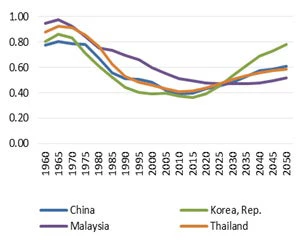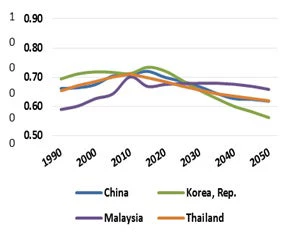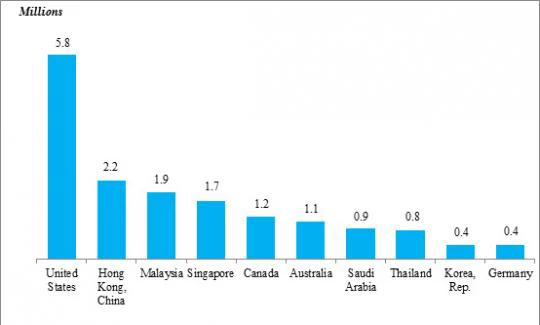In observance of the International Migrants Day, Dec 18

East Asian economies are known for their high rates of growth and poverty reduction, bustling trade, robust capital flows and booming manufacturing exports. Lost in this is the important role of labor migration and remittances in developing the region, but this role is very real. Historically, migrants went from China, Japan and Korea to the far flung parts of Americas and Asia and flourished. The small but well maintained Japanese Overseas Migration History in Yokohama remembers the great Japanese migration with loving care (see photo from http://en.japantravel.com/view/japanese-overseas-migration-museum). In the case of Korea, as a Korean researcher noted in a conference we had organized at the National University in Singapore on Migration and Development, remittances from Korean workers were important in helping to manage Korea’s economy well into the 1970s.
Migration is still playing a major role in East Asian economies and its importance is likely to increase in the coming decades. This is a key message from the economic work carried out by the EAP Chief Economist’s office carried out in partnership between researchers from think tanks and universities in six East Asian countries and World Bank staff and published in two reports: (i) International Migration and Development in East Asia and the Pacific (https://openknowledge.worldbank.org/handle/10986/20437) and (ii) a volume of research papers titled Managing International Migration for Development in East Asia. We will present the findings of this work in future blogs. Here are some of the highlights:
- The East Asia region contains both labor-sending countries (source countries) and labor receiving countries (destination) countries and some countries, such as Thailand both send and receive workers. In fact, East Asian economies figure prominently among the top destinations for East Asian workers.
- These countries depend significantly on migrant workers and remittances for boosting household incomes, supporting macroeconomic stability and enhancing economic competitiveness. Currently the region’s countries have sent out nearly 22 million migrants who remitted US$112 billion to their home countries in 2012, a far larger sum than official development assistance. The region also hosts 7 million migrants from within the region and places such as South Asia.
- Remittances helped to reduce poverty by increasing income for migrants’ families, loosening credit constraints for migrants, and insuring migrants’ households against shocks. At the economy wide level, remittances financed trade deficits and bolstered reserves not just in the small Pacific Islands but also in large countries such as Vietnam and the Philippines – where remittances can be as large as 7 percent of GDP.
- On the other side, for some receiving countries such as Malaysia, Singapore and Hong Kong, migrant workers form a significant part of the work force, especially in labor intensive manufacturing, construction, plantation agriculture, fishing and household services. This has helped to relieve labor shortages, maintain competitiveness and enabled local workers to move into higher and more productive occupations in countries such as Malaysia.
- International migration in East Asia and the Pacific is set to become an even more important policy issue for two reasons. First, alongside, trade, investment and capital flows, cross-border labor mobility is part of the “deep” economic integration taking place in the region. This is most explicitly recognized in the ASEAN Economic Community Goals, which include the free movement of skilled workers within ASEAN by 2015. Second, the East Asia and Pacific region is facing the onset of one of the most rapid demographic changes in history. Rapidly ageing labor-receiving countries—such as Japan, the Republic of Korea, and over time even Thailand (see below) — will have to manage a reduction in the domestic labor supply, while rising demand for services will increase labor demand. Taken together, these two forces will create important labor shortages in labor-receiving countries, which, if unmet, will lower economic growth and sharply increase fiscal and health costs. Given these factors, the key question concerning international migration in East Asia and the Pacific is not whether it is desirable but how it should be managed in the future. And as the work suggested, good policies are needed for managing future migration because the migration industry is marked by deep market failures and implementation challenges.
| Dependency ratios are on the rise after Than 64 relative to the rest of the population) |
…Reflecting a decline in the working |
 |
 |
| Source: UN World Population Prospects and World Bank staff calculations | |
- In fact, our work suggested that while the short run benefits of migration and remittances are significant, the long run impact of migration and remittances is well below their potential. Large income differentials, porous borders in the Mekong region and between Malaysia and Indonesia create powerful economic forces for migration. But, unequal and inadequate access to information for workers in particular, but also for employers can give rise to fraudulent and abusive practices of recruitment agencies and brokers. Transactions costs and fees are high and more so for documented workers than undocumented ones, creating incentives for the irregular migration. And sending remittances can be costly and workers often lack access to savings instruments and other financial services that could enhance the development impact of remittances.
- In labor receiving countries, governments should consider adopting policies that provide equal treatment of migrant workers to avoid creating incentives for employers to displace local workers with cheaper foreign ones. Programs to upgrade the skills of local workers can offset negative distributional consequences and increase the gains from migration. Particularly important will be to recognize that greater support for the rights of migrant workers through fair wages and safe working conditions can benefit all concerned. These policies, if implemented, will ensure that migration will continue to benefit migrants, sending countries and receiving countries alike across East Asia and the Pacific.



Join the Conversation